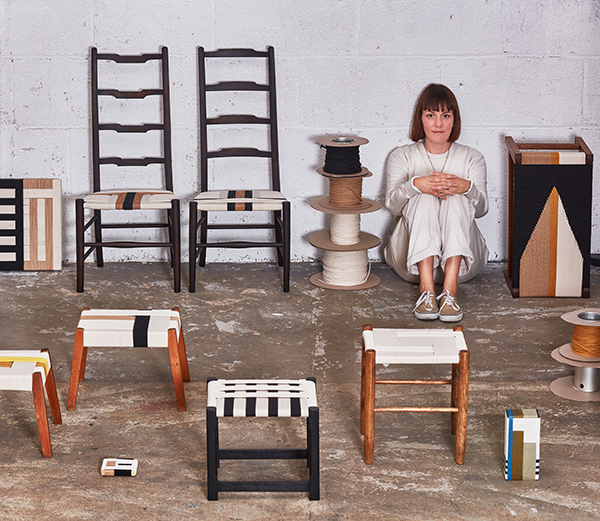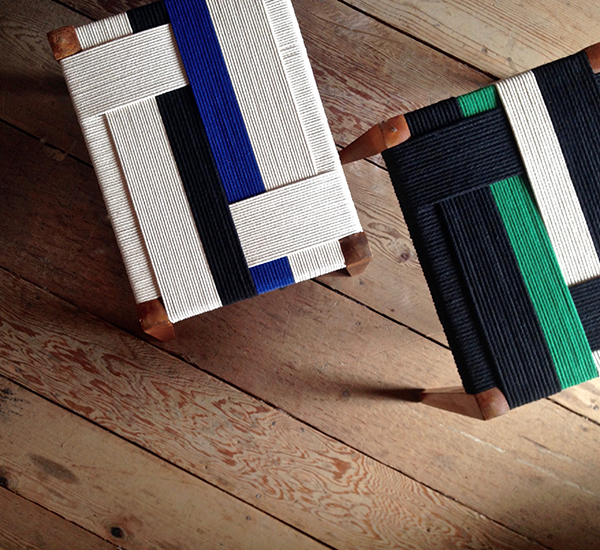One of my favourites from London Design Fair was a collection of furniture that immediately stood apart for its elegant and distinctive graphic aesthetic. The artist behind this body of work was Jo Elbourne of Cumulo Design, who works from her studio in Margate on the Kent coast.
I later discovered that her collection is actually made up of reworked pieces of found furniture and wasn’t surprised to hear that she had won ‘Best in Craft’ in the Elle Decoration British Design Awards 2017. I was very excited to connect with Jo and share her story. Here, she reveals how she entered the realm of contemporary textile weaving.
What is your creative background and how did it lead to textiles and found objects?
I’d often be absorbed in art or playing music for hours as a child. I went to an academic school but stuck with the creative subjects. I did a one year foundation course at Wimbledon School of Art, followed by a Fashion degree at Ravensbourne College of Design in South London.
I worked as a menswear and denim designer for several years but as sketching by hand was gradually phased out, I was spending the majority of my working time at a computer, designing products which I had little connection to.
Working with found objects was borne slightly out of necessity… I wasn’t sure what I was going to make or what for, I just wanted to begin, and these things – some string and an old chair – were what I had to hand.
How would you describe your creative process?
When I have time, I work intuitively. It’s often the best way to find a new idea and I enjoy the element of problem-solving which comes from making, without a plan.
I take a lot of photos during the process as interesting ideas and layers present themselves at various stages, but you might only notice them afterwards. These moments can inform the next thing I make.
The string-wrapped bricks and the small woven pieces each allow me to explore colour, shape and texture which may not be practical in a piece of furniture. The stools and chair seats are usually made in response to the frames themselves.
How long does it take to make each piece?
This really varies. I used to undo and re-do a lot to understand the method, but I’m better at visualising now.
In terms of speed, I’ve learnt that it can make a big difference where to begin and end a piece, and the order each section is wrapped. Once I’ve done one, it’s usually quite fast to make another, but I try never to repeat myself exactly.

Where do you source your furniture from?
This varies, from antiques fairs and eBay, to friends and very occasionally, skips! Clients sometimes provide their own frames for me to rework.
I also work on an ad-hoc basis with a secondhand shop called Committee of Taste who source frames which I then re-work and return to be sold in their shop.
What’s the most exciting thing you’ve discovered from developing your weaving technique?
Perhaps that the possibilities seem so endless even though the premise is so simple – that cord is wrapped one way, and then another.
The exploratory process is as important to me as the finished piece. There is often a rhythm to the work which is totally absorbing.
It’s also hugely encouraging that people have responded positively and connected with what I’m doing. I like the idea that it might inspire someone to have their old chair or stool re-worked rather than getting rid of it.
Where do you find inspiration for your designs?
Architectural scenes and spaces. Sometimes simply colour combinations. Often the actual process inspires the next idea. I like the work of abstract minimalist artists such as Agnes Martin, Sol Lewitt, Carmen Herrera and Lygia Clark too.
What kind of interiors are you works most suited to?
I only really imagine a setting for pieces when I am working to commission, then it’s obviously very important that the piece works within the client’s space. Otherwise, I think they seem to make sense either within a very minimal interior, or one that has a bold clash of styles and patterns, with very little in between!
Is your work influenced by the city your live in?
I live on the Kent coast and living by the sea has indirectly had an influence. Obviously I’m not weaving seascapes or beach huts! but the openness and the light and the closeness to water – this definitely alters your thinking.
I work out of Resort Studios in Margate – a shared studio which now has 40 members across several disciplines. There are fine artists, designers, printmakers, photographers, architects, writers and filmmakers. The creative diversity there is inspiring.
Which is your favourite piece and why?
I love making the String Bricks (literally bricks wrapped with string) – they are odd things to some people and they take absolutely ages to make, but I feel the most free with these to try new ideas, which then inform subsequent work.

What do you enjoy doing on your days off?
Getting to exhibitions, having long lunches and being outdoors. Time spent with friends is important to balance out the solitude of making.
What are you working on currently/next?
I’m currently working on a bedhead – by far the largest thing I have ever made and using a new material, so it’s been quite a learning curve. I’m looking forward to developing more of the wall-based artworks which were so well-received at London Design Fair. The show has lead to some really exciting commission opportunities. I will also be working on a new collection of pieces with Committee of Taste in the coming months.

Jo’s works are currently made to order and commissions start at £180.
Portrait by Joel Knight









